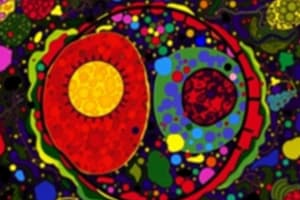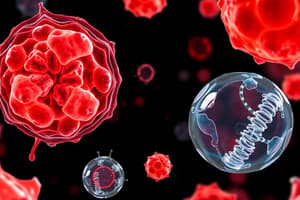Podcast
Questions and Answers
Which of the following statements correctly describes the function of the cell membrane?
Which of the following statements correctly describes the function of the cell membrane?
- It is a rigid structure that provides support and protection for the cell.
- It is a selectively permeable barrier that controls the movement of substances into and out of the cell. (correct)
- It is a permeable barrier that allows all substances to pass through freely.
- It is the site of protein synthesis in the cell.
Which of the following is NOT a characteristic shared by all living organisms?
Which of the following is NOT a characteristic shared by all living organisms?
- They are composed of cells.
- They reproduce by dividing into two daughter cells. (correct)
- They require energy to carry out life processes.
- They respond to stimuli in their environment.
What is the primary function of mitosis in a cell?
What is the primary function of mitosis in a cell?
- To produce offspring through asexual reproduction.
- To repair damaged tissues and replace worn-out cells. (correct)
- To increase the genetic diversity of a population.
- To produce gametes (sex cells) for sexual reproduction.
Which of the following best describes the relationship between surface area and volume as a cell grows?
Which of the following best describes the relationship between surface area and volume as a cell grows?
Which of the following is a key difference between Archaea and Bacteria?
Which of the following is a key difference between Archaea and Bacteria?
Which of the following is NOT a mechanism that can lead to the formation of new species?
Which of the following is NOT a mechanism that can lead to the formation of new species?
What is the main difference between the cell walls of plant and animal cells?
What is the main difference between the cell walls of plant and animal cells?
Which of the following best explains the process of natural selection?
Which of the following best explains the process of natural selection?
Flashcards
Why are cells small?
Why are cells small?
Cells have a limit on their size due to the relationship between their surface area and volume. As cells grow, their volume increases faster than their surface area, making it harder for them to efficiently transport nutrients and waste materials.
What happens in the cell cycle?
What happens in the cell cycle?
The cell cycle is a series of events that occur in a cell leading to its growth and division. It involves three main stages: S phase (DNA replication), mitosis (nucleus division), and cytokinesis (cell splitting).
What is the cell membrane?
What is the cell membrane?
The cell membrane is a thin layer surrounding the cell. It's made of lipids (fats) with water-loving heads and water-fearing tails. This structure helps the cell membrane control what enters and exits the cell.
What is evolution?
What is evolution?
Signup and view all the flashcards
What are mutations?
What are mutations?
Signup and view all the flashcards
What causes new species?
What causes new species?
Signup and view all the flashcards
What is the cell theory?
What is the cell theory?
Signup and view all the flashcards
How do we classify organisms?
How do we classify organisms?
Signup and view all the flashcards
Study Notes
Cell Growth and Division (Chapter 11)
- Cells grow, but their volume increases faster than their surface area. Small cells are more efficient at moving nutrients and waste.
- The cell cycle involves several stages:
- S Phase: DNA replication occurs.
- Mitosis: The nucleus divides.
- Cytokinesis: The cell splits into two.
- Cell size is limited by the surface area-to-volume ratio and the efficiency in moving materials and DNA. Mitosis ensures that new cells have the same DNA as the original cells.
Cell Structure and Function (Chapter 8)
- The cell theory states that all living things are made of cells, cells are the basic unit of life, and new cells come from pre-existing cells.
- Plant cells have a cell wall and chloroplasts, whereas both plant and animal cells have cell membranes and mitochondria.
- Cell membranes are made of fats with water-friendly heads and water-repelling tails, regulating what enters and exits the cell.
- Ribosomes build proteins, and the Golgi apparatus packages them.
Evolution and Natural Selection (Chapters 17 & 18)
- Evolution is the change in species over time due to natural selection.
- Natural selection is where organisms with traits advantageous for their environment are more likely to survive and reproduce, passing on those traits.
- New species can form due to geographic isolation, which separates a population and prevents interbreeding, or reproductive isolation, where groups within a population stop breeding together.
- Mutations in DNA can create differences, aiding evolution.
- Darwin observed that island species resembled mainland species but had adaptations specific to their unique island environments.
Classification and Characteristics of Life (Chapters 1 & 19)
- Organisms are classified using scientific names, like Felis catus (cat).
- Characteristics of life include being made of cells, responding to the environment, growing and reproducing, and using energy.
- Archaea and bacteria are single-celled, but have different cell wall structures.
- Kingdoms, like animals and plants, exhibit different characteristics:
- Animals move and do not produce their own food.
- Plants stay in one place and use sunlight to produce their food.
Studying That Suits You
Use AI to generate personalized quizzes and flashcards to suit your learning preferences.
Related Documents
Description
Explore the crucial processes of cell growth and division alongside cell structure and function in this quiz. Understand the cell cycle phases, the importance of surface area-to-volume ratio, and the unique attributes of plant and animal cells. Test your knowledge on cell theory and the role of organelles in cellular activities.




